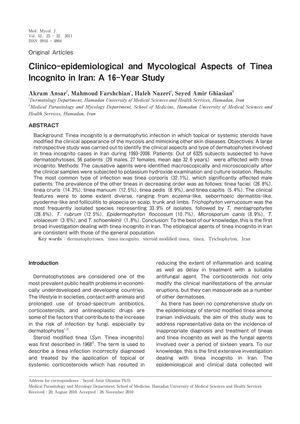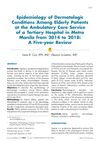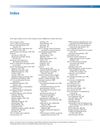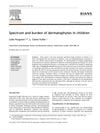Clinico-Epidemiological and Mycological Aspects of Tinea Incognito in Iran: A 16-Year Study
January 2011
in “
Nippon Ishinkin Gakkai Zasshi
”
tinea incognito tinea corporis tinea faciei tinea cruris tinea manuum tinea pedis tinea capitis alopecia Trichophyton verrucosum Trichophyton mentagrophytes Trichophyton rubrum Epidermophyton floccosum Microsporum canis Trichophyton violaceum Trichophyton schoenleinii ringworm athlete's foot jock itch scalp ringworm

TLDR Tinea incognito in Iran commonly affects adults and mimics other skin conditions.
A 16-year retrospective study in Iran (1993-2008) identified 56 cases of tinea incognito among 6325 suspected dermatophytosis patients. The mean age was 32.6 years, with a nearly equal gender distribution (29 males, 27 females). Tinea corporis was the most common infection (32.1%), predominantly affecting males, followed by tinea faciei (26.8%), tinea cruris (14.3%), tinea manuum (12.5%), tinea pedis (8.9%), and tinea capitis (5.4%). Clinical presentations varied widely, mimicking conditions like eczema, seborrhoeic dermatitis, pyoderma, folliculitis, and alopecia. Trichophyton verrucosum was the most frequently isolated species (33.9%), followed by T. mentagrophytes (28.6%), T. rubrum (12.5%), Epidermophyton floccosum (10.7%), Microsporum canis (8.9%), T. violaceum (3.6%), and T. schoenleinii (1.8%). This study was the first extensive investigation of tinea incognito in Iran, with etiological agents consistent with those in the general population.


